+ Open data
Open data
- Basic information
Basic information
| Entry | Database: PDB / ID: 1fkc | ||||||
|---|---|---|---|---|---|---|---|
| Title | HUMAN PRION PROTEIN (MUTANT E200K) FRAGMENT 90-231 | ||||||
 Components Components | PRION PROTEIN PRNP PRNP | ||||||
 Keywords Keywords |  MEMBRANE PROTEIN / three helix / CREUTZFELDT-JAKOB DISEASE / MEMBRANE PROTEIN / three helix / CREUTZFELDT-JAKOB DISEASE /  PRION / AGGREGATION PRION / AGGREGATION | ||||||
| Function / homology |  Function and homology information Function and homology information: / negative regulation of amyloid precursor protein catabolic process /  lamin binding / regulation of glutamate receptor signaling pathway / regulation of calcium ion import across plasma membrane / aspartic-type endopeptidase inhibitor activity / lamin binding / regulation of glutamate receptor signaling pathway / regulation of calcium ion import across plasma membrane / aspartic-type endopeptidase inhibitor activity /  glycosaminoglycan binding / NCAM1 interactions / negative regulation of interleukin-17 production / ATP-dependent protein binding ...: / negative regulation of amyloid precursor protein catabolic process / glycosaminoglycan binding / NCAM1 interactions / negative regulation of interleukin-17 production / ATP-dependent protein binding ...: / negative regulation of amyloid precursor protein catabolic process /  lamin binding / regulation of glutamate receptor signaling pathway / regulation of calcium ion import across plasma membrane / aspartic-type endopeptidase inhibitor activity / lamin binding / regulation of glutamate receptor signaling pathway / regulation of calcium ion import across plasma membrane / aspartic-type endopeptidase inhibitor activity /  glycosaminoglycan binding / NCAM1 interactions / negative regulation of interleukin-17 production / ATP-dependent protein binding / regulation of potassium ion transmembrane transport / negative regulation of dendritic spine maintenance / type 5 metabotropic glutamate receptor binding / cupric ion binding / negative regulation of protein processing / negative regulation of interleukin-2 production / negative regulation of calcineurin-NFAT signaling cascade / glycosaminoglycan binding / NCAM1 interactions / negative regulation of interleukin-17 production / ATP-dependent protein binding / regulation of potassium ion transmembrane transport / negative regulation of dendritic spine maintenance / type 5 metabotropic glutamate receptor binding / cupric ion binding / negative regulation of protein processing / negative regulation of interleukin-2 production / negative regulation of calcineurin-NFAT signaling cascade /  dendritic spine maintenance / negative regulation of T cell receptor signaling pathway / Insertion of tail-anchored proteins into the endoplasmic reticulum membrane / dendritic spine maintenance / negative regulation of T cell receptor signaling pathway / Insertion of tail-anchored proteins into the endoplasmic reticulum membrane /  extrinsic component of membrane / negative regulation of amyloid-beta formation / cuprous ion binding / negative regulation of activated T cell proliferation / negative regulation of long-term synaptic potentiation / response to amyloid-beta / negative regulation of type II interferon production / : / intracellular copper ion homeostasis / positive regulation of protein targeting to membrane / extrinsic component of membrane / negative regulation of amyloid-beta formation / cuprous ion binding / negative regulation of activated T cell proliferation / negative regulation of long-term synaptic potentiation / response to amyloid-beta / negative regulation of type II interferon production / : / intracellular copper ion homeostasis / positive regulation of protein targeting to membrane /  long-term memory / positive regulation of protein tyrosine kinase activity / response to cadmium ion / long-term memory / positive regulation of protein tyrosine kinase activity / response to cadmium ion /  inclusion body / regulation of peptidyl-tyrosine phosphorylation / cellular response to copper ion / molecular condensate scaffold activity / neuron projection maintenance / inclusion body / regulation of peptidyl-tyrosine phosphorylation / cellular response to copper ion / molecular condensate scaffold activity / neuron projection maintenance /  tubulin binding / protein sequestering activity / negative regulation of protein phosphorylation / molecular function activator activity / positive regulation of protein localization to plasma membrane / protein destabilization / protein homooligomerization / negative regulation of DNA-binding transcription factor activity / tubulin binding / protein sequestering activity / negative regulation of protein phosphorylation / molecular function activator activity / positive regulation of protein localization to plasma membrane / protein destabilization / protein homooligomerization / negative regulation of DNA-binding transcription factor activity /  terminal bouton / cellular response to amyloid-beta / positive regulation of neuron apoptotic process / positive regulation of peptidyl-tyrosine phosphorylation / cellular response to xenobiotic stimulus / terminal bouton / cellular response to amyloid-beta / positive regulation of neuron apoptotic process / positive regulation of peptidyl-tyrosine phosphorylation / cellular response to xenobiotic stimulus /  signaling receptor activity / signaling receptor activity /  amyloid-beta binding / protein-folding chaperone binding / amyloid-beta binding / protein-folding chaperone binding /  microtubule binding / postsynapse / microtubule binding / postsynapse /  nuclear membrane / response to oxidative stress / nuclear membrane / response to oxidative stress /  protease binding / transmembrane transporter binding / protease binding / transmembrane transporter binding /  postsynaptic density / learning or memory / molecular adaptor activity / postsynaptic density / learning or memory / molecular adaptor activity /  regulation of cell cycle / regulation of cell cycle /  cell cycle / copper ion binding / cell cycle / copper ion binding /  membrane raft / external side of plasma membrane / intracellular membrane-bounded organelle / membrane raft / external side of plasma membrane / intracellular membrane-bounded organelle /  dendrite / protein-containing complex binding / negative regulation of apoptotic process / dendrite / protein-containing complex binding / negative regulation of apoptotic process /  Golgi apparatus / Golgi apparatus /  cell surface / cell surface /  endoplasmic reticulum / extracellular exosome / identical protein binding / endoplasmic reticulum / extracellular exosome / identical protein binding /  plasma membrane / plasma membrane /  cytosol / cytosol /  cytoplasm cytoplasmSimilarity search - Function | ||||||
| Biological species |   Homo sapiens (human) Homo sapiens (human) | ||||||
| Method |  SOLUTION NMR / SOLUTION NMR /  simulated annealing, simulated annealing,  molecular dynamics molecular dynamics | ||||||
 Authors Authors | Zhang, Y. / Swietnicki, W. / Zagorski, M.G. / Surewicz, W.K. / Soennichsen, F.D. | ||||||
 Citation Citation |  Journal: J.Biol.Chem. / Year: 2000 Journal: J.Biol.Chem. / Year: 2000Title: Solution structure of the E200K variant of human prion protein. Implications for the mechanism of pathogenesis in familial prion diseases. Authors: Zhang, Y. / Swietnicki, W. / Zagorski, M.G. / Surewicz, W.K. / Sonnichsen, F.D. | ||||||
| History |
|
- Structure visualization
Structure visualization
| Structure viewer | Molecule:  Molmil Molmil Jmol/JSmol Jmol/JSmol |
|---|
- Downloads & links
Downloads & links
- Download
Download
| PDBx/mmCIF format |  1fkc.cif.gz 1fkc.cif.gz | 41.9 KB | Display |  PDBx/mmCIF format PDBx/mmCIF format |
|---|---|---|---|---|
| PDB format |  pdb1fkc.ent.gz pdb1fkc.ent.gz | 32.6 KB | Display |  PDB format PDB format |
| PDBx/mmJSON format |  1fkc.json.gz 1fkc.json.gz | Tree view |  PDBx/mmJSON format PDBx/mmJSON format | |
| Others |  Other downloads Other downloads |
-Validation report
| Arichive directory |  https://data.pdbj.org/pub/pdb/validation_reports/fk/1fkc https://data.pdbj.org/pub/pdb/validation_reports/fk/1fkc ftp://data.pdbj.org/pub/pdb/validation_reports/fk/1fkc ftp://data.pdbj.org/pub/pdb/validation_reports/fk/1fkc | HTTPS FTP |
|---|
-Related structure data
- Links
Links
- Assembly
Assembly
| Deposited unit | 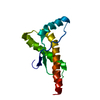
| |||||||||
|---|---|---|---|---|---|---|---|---|---|---|
| 1 |
| |||||||||
| NMR ensembles |
|
- Components
Components
| #1: Protein |  PRNP PRNPMass: 16169.063 Da / Num. of mol.: 1 / Fragment: PRP(90-231) / Mutation: E200K Source method: isolated from a genetically manipulated source Source: (gene. exp.)   Homo sapiens (human) / Description: BRAIN / Organ: BRAIN Homo sapiens (human) / Description: BRAIN / Organ: BRAIN / Plasmid: PET3 / Production host: / Plasmid: PET3 / Production host:   Escherichia coli (E. coli) / References: UniProt: P04156 Escherichia coli (E. coli) / References: UniProt: P04156 |
|---|
-Experimental details
-Experiment
| Experiment | Method:  SOLUTION NMR SOLUTION NMR | ||||||||||||
|---|---|---|---|---|---|---|---|---|---|---|---|---|---|
| NMR experiment |
| ||||||||||||
| NMR details | Text: The structure was determined using triple-resonance NMR spectroscopy. |
- Sample preparation
Sample preparation
| Details | Contents: 0.8 mM E200K(90-231)PrP U-15N,13C; 10mM acetate buffer Solvent system: 90% H2O/10% D2O |
|---|---|
| Sample conditions | Ionic strength: 0.00001 / pH: 4.6 / Pressure: 1 atm / Temperature: 299 K |
Crystal grow | *PLUS Method: other / Details: NMR |
-NMR measurement
| NMR spectrometer |
|
|---|
- Processing
Processing
| NMR software |
| ||||||||||||||||
|---|---|---|---|---|---|---|---|---|---|---|---|---|---|---|---|---|---|
| Refinement | Method:  simulated annealing, simulated annealing,  molecular dynamics / Software ordinal: 1 molecular dynamics / Software ordinal: 1 | ||||||||||||||||
| NMR representative | Selection criteria: lowest energy | ||||||||||||||||
| NMR ensemble | Conformer selection criteria: structures with the lowest energy Conformers calculated total number: 60 / Conformers submitted total number: 1 |
 Movie
Movie Controller
Controller



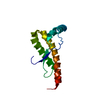

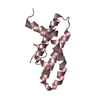
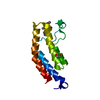



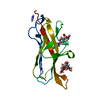

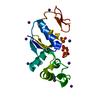

 PDBj
PDBj


